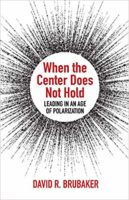Every congregation is unique. It is located in a specific place, has a particular history, and evidences a unique culture. Yet dynamics and patterns of behavior recur across denominations, polities, and locations. Following are a set of congregational constants that I’ve observed across religious traditions. Each reader can decide whether they are true of your congregation, and if so, how they might help you to become a more effective leader.
Leadership
Leaders set the tone in every congregation. As goes the leadership, so goes the congregation. After three decades of consulting, I can now predict whether a conflicted congregation will heal and come together or fracture and come apart. The key variable is how the leadership of that congregation chooses to manage the conflict. If leaders, both ordained and lay, commit to stay respectfully connected despite their differences, members of the congregation invariably follow suit. But if leaders pull away from each other and establish opposing camps, the rest of the congregation will do likewise.
Structure
Every time we restructure, we exchange one set of problems for a new set of problems. Many congregations are living with congregational structures that no longer fit their current reality. In some cases an elaborate structure that was appropriate for over 1,000 members has become burdensome for a congregation half as large. In other situations, a highly participatory decision-making structure has become so sluggish it inhibits the adaptive changes now required. When this occurs, a structure review process is often appropriate. Such a process is not, however, a panacea.
Culture
Culture trumps structure every time. Culture eats strategy for breakfast. (Peter Drucker) New ministers and rabbis quickly discover the power of a congregation’s culture when they begin ministry or service. While congregations do resist structural changes, their reaction to perceived violations of their culture is much stronger. Culture is expressed through visible artifacts and rituals, and reflects the allocation of power. This is why changes in those areas so often provoke strong emotions—as the pastor who replaced the organ with a drum set after his first Sunday quickly discovered!
Change
We must earn the right to make change. We can only change what we first love. There are seasons when the leadership, structure, or culture of a congregation must change—at least if the congregation desires a healthy future. But successful change agents know that before they can make change, they must first earn the right to do so by building trusting relationships through listening. Congregational members can intuitively sense whether a leader is operating out of love for the congregation and its people or from ego-driven motives.
Conflict
The best antidote to destructive internal conflict is an external focus. In times of congregational conflict there are inevitable calls to “identify the issues,” “plan a process,” and “resolve the conflict.” These are useful instincts, and I have worked with scores of congregations to implement such processes. But beyond the identified issues and the internal process needed to address them, the most effective intervention is often simply helping a congregation to look out the window. An external focus, particularly on the needs of a congregation’s own community, is the most effective antidote to internal conflict.
If you have concluded that some of these “truisms” are true for your congregation, what are the implications? I suggest five commitments:
- Focus on leadership development and building a strong sense of “team” among your leaders. There are many ways to work at this, as discussed in the leadership literature. Since leaders set the tone for others, developing a “group covenant” (regarding how leaders will relate to each other) is one effective mechanism to strengthen that tone. If leaders model treating others with dignity and respect that will have a knock-on effect throughout the congregation.
- When it is time to restructure, don’t over-promise regarding the benefits of doing so. Structure should serve the congregation (not vice versa), and if your current structure no longer does so, it may be necessary to change it. As you restructure, recognize that there will be some resistance and that your structure will likely need to change again in another five or ten years. Structure doesn’t solve our problems—at best it provides us with some useful mechanisms for doing so.
- Take the time to learn the culture of your congregation. We do this not only by observing the rituals and artifacts, but also by learning the stories of the congregation. What were the “glory years” and who were the “heroes?” When were the “lean years” and what traumas did the congregation endure? From these stories we learn what the congregation most values, and we can build on those values and cultural norms for the next phase of the congregation’s lifecycle.
- When change initiatives are needed in your congregation, lead them out of your love for the congregation and its people—not out of your displeasure about what is wrong and “must be fixed.” People will notice the process and the intentions with which you work for change much more than the specifics of your change proposal. Congregations, like individuals, are more likely to accept change initiatives from people they believe love and care about them.
- If you desire to see conflict stay at manageable levels in your congregation, focus on the ways in which your congregation is involved in mission and ministry beyond itself. This could range from participating in a local food bank to international service. What most matters is that members are actually involved in mission and service beyond the walls of your congregation. When we look out the window, we become less obsessed with the conflicts that are inside the house.
Every congregation is unique, yet most of them exhibit remarkably similar characteristics. By understanding classic patterns of behavior, leaders can become more effective agents of change.
David Brubaker has consulted with organizations and congregations in the U.S. and a dozen other countries on organizational development and conflict transformation. He is the author of Promise and Peril, on managing change and conflict in congregations, and When the Center Does Not Hold, on leading in an age of polarization. David recently retired from his role as Dean of the School of Social Sciences and Professions at Eastern Mennonite University, and is now a Professor Emeritus of Organizational Studies.



